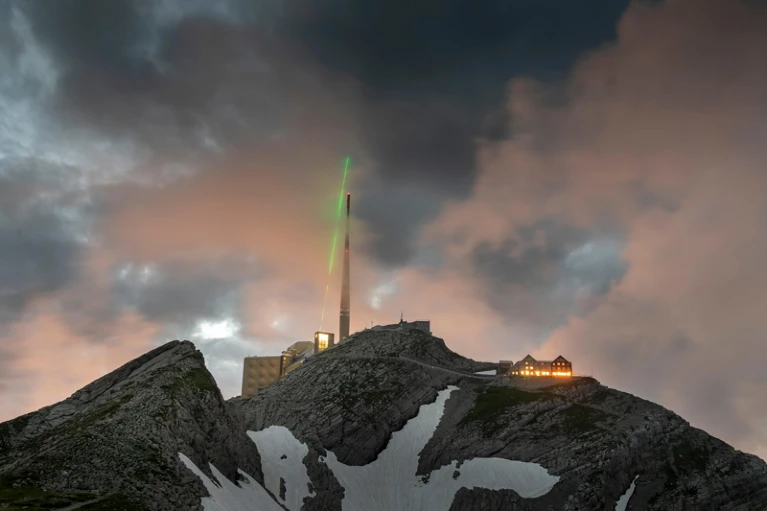
It will take time to shrink the system and make it cheaper and more practical
Elizabeth Gibney
A rapidly firing laser can divert lightning strikes, scientists have shown for the first time in real-world experiments1. The work suggests that laser beams could be used as lightning rods to protect infrastructure, although perhaps not any time soon.
“The achievement is impressive given that the scientific community has been working hard along this objective for more than 20 years,” says Stelios Tzortzakis, a laser physicist at the University of Crete, Greece, who was not involved in the research. “If it’s useful or not, only time can say.”
Metal lightning rods are commonly used to divert lightning strikes and safely dissipate their charge. But the rods’ size is limited, meaning that so, too, is the area they protect.
Physicists have wondered whether lasers could enhance protection, because they can reach higher into the sky than a physical structure and can point in any direction. But despite successful laboratory demonstrations, researchers have never before succeeded in field campaigns, says Tzortzakis.
Bolt from the blue
To change that, a group of roughly 25 researchers set up the Laser Lightning Rod project, which trialed a specially created €2 million (US$2 million) high-power laser in the Swiss Alps. The scientists placed the laser next to the Säntis telecommunications tower, which is hit frequently by lightning. “This is one of those projects that everyone was waiting for the results of,” says Valentina Shumakova, a laser physicist at the University of Vienna.
A sufficiently intense laser beam can create a conductive path for lightning to travel down, just as a metal wire can. Physicists think that it does this by shifting the properties of air so that the beam focuses into a thin, intense filament. This rapidly heats the air, reducing its density and creating a favorable path for lightning. “It’s like drilling a hole through the air with the laser,” says Aurélien Houard, a physicist at the Laboratory of Applied Optics in Paris, who led the project.
Rather than try to divert lightning from the tower, the Säntis experiments were designed to show that the laser could guide a strike’s path through the structure’s lightning rod. In future use, similar beams would guide strikes away from sensitive installations and onto a distant lightning rod, says Houard.
Guided lightning
Over 10 weeks of observation, the team spotted the laser channeling 4 lightning events during 6 hours of thunderstorms. A high-speed camera clearly showed one strike following the straight line of the laser beam, rather than taking a branching path.
“For 100% of the strikes where the laser was present, we measured an effect of the laser,” says Houard. But Tzortzakis notes that the laser was also active for many hours without channeling strikes. This suggests that although the laser diverted lightning, it did not force thunderclouds to discharge, which would be a better protection strategy, he says.
The latest effort succeeded where others had failed, says Tzortzakis, because previous attempt had used a laser that fired just a few pulses per second. This team used a specialist laser that fires 1,000 high-energy pulses per second, which would have boosted its chance of intercepting the lightning.
However, the fact that the project’s laser is one of a kind is also its biggest limitation, because it will take time to shrink the system and make it cheaper and more practical, says Houard.
_______________________
Courtesy: Nature (Published on Jan 16, 2023)